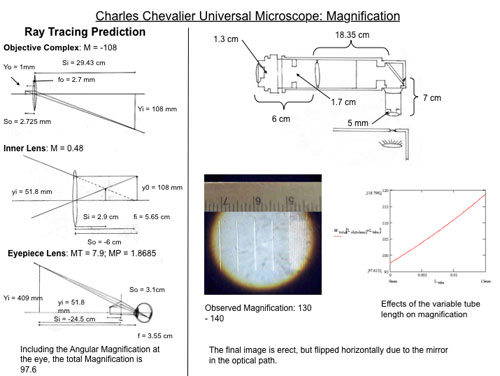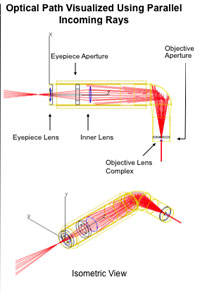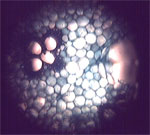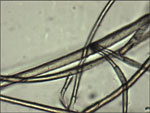 |
|||||
 |
 |
||||
 |
|||||
 |
 |
||||
The optics of a early 19th Century compound microscope; the Chevalier Universal microscope |
|||||||||||||||||||||||||||||
|
Magnification and Modeling
|
|||||||||||||||||||||||||||||
 |
 |
||||||||||||||||||||||||||||
|
The presence of apertures near each lens system reduces achromatic aberrations (e.g., spherical).
|
|||||||||||||||||||||||||||||
| The Chevalier microscope consists of three lens systems: The objective system, a Field lens ("inner lens"), and the eyepiece system. The total magnification was calculated to be approximately 100x and observed to be 130-140x. Magnification was calculated a the 3-lens objective | |||||||||||||||||||||||||||||
|
|
|||||||||||||||||||||||||||||
|
|||||||||||||||||||||||||||||
| Chromatic Aberration | |||||||||||||||||||||||||||||
 |
 |
 |
|||||||||||||||||||||||||||
|
Difference in focus positions between Red and Green illumination
|
|||||||||||||||||||||||||||||
|
Green light
|
White light
|
Red light
|
|||||||||||||||||||||||||||
| Although this instrument was marketed as an "Achromatic" microscope, it clearly exhibits chromatic aberration, as shown by these target images. All lenses have different focal lengths depending on the color of light used. The slight blurriness of the white light image is a result of different colors of light focusing in different places. In color the halo would appear as color fringes. (How they determined this.) | |||||||||||||||||||||||||||||
|
|
|||||||||||||||||||||||||||||
| Resolution and Sample Images | |||||||||||||||||||||||||||||
|
Determining Resolution
0.01mm micrometer scale Demonstrates <<10µm resolving power |
Calculating Resolution (q)
F1 = 2.7mm, l = 550nm, D1 = 4mm |
||||||||||||||||||||||||||||
 |
|||||||||||||||||||||||||||||
|
Sample Images
|
|||||||||||||||||||||||||||||
 |
 |
 |
 |
||||||||||||||||||||||||||
|
Cross section of a bamboo stem.
Chevalier (L) compared to modern Zeiss microscope (R) |
Chevalier image of camel hairs (L) and modern microsocpe (R). Image quality is also a function of the camera: Web cam (L) and 5MPix scientific digital camera (R).
|
||||||||||||||||||||||||||||